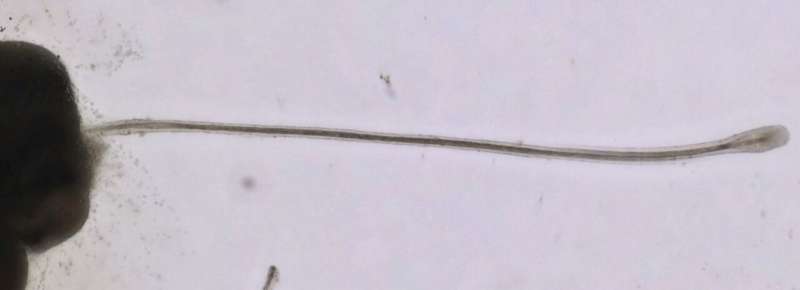Fully mature hair follicles grown in cultures

A team of researchers from Japan studying the processes of hair follicle growth and hair pigmentation has successfully generated hair follicles in cultures. Their in vitro hair follicle model adds to the understanding of hair follicle development which could contribute to development of useful applications in treating hair loss disorders, animal testing, and drug screenings.
Their findings were published in Science Advances on October 21.
As an embryo develops, interactions occur between the outer layer of skin called the epidermal layer and the connective tissue called mesenchyme. These interactions work kind of like a messenger system to trigger hair follicle morphogenesis. Morphogenesis is the process in an organism where cells are organized into tissues and organs.
During the last several decades, scientists have explored the crucial mechanisms related to hair follicle development using animal models. Because fully understanding these mechanisms for hair follicle development remains challenging, hair follicle morphogenesis has not been successfully reproduced in a laboratory culture dish.
More recently organoid cultures have received widespread attention. Organoids are tiny, simple versions of an organ—scientists produce and use them to study tissue and organ development and pathology in a laboratory culture dish. "Organoids were a promising tool to elucidate the mechanisms in hair follicle morphogenesis in vitro," said Tatsuto Kageyama, an assistant professor with the faculty of engineering at Yokohama National University.
The research team fabricated hair follicle organoids by controlling the structure generated from the two types of embryonic cells using quite a low concentration of extracellular matrices. The extracellular matrix is the framework in the body that provides structure for cells and tissue. The extracellular matrices adjusted the spacing between the two types of embryonic cells from a dumbbell-shape to core-shell configuration. Newly formed hair follicles with typical features emerged in core-shell-shape groups. These core-shell-shape groups increase the contact area between two cell regions to enhance the mechanisms that contribute to hair follicle growth.
The organoid culture system the research team developed generated hair follicles and hair shafts with almost 100 percent efficiency. The hair follicle organoids produced fully mature hair follicles with long hair shafts (approximately 3 mm length on 23 days of culture). As this growth occurred, the researchers could monitor hair follicle morphogenesis and hair pigmentation in vitro and understand the signaling pathways involved in the processes.
The researchers examined the feasibility of hair follicle organoids for drug screening and regenerative medicine. Then they added a melanocyte-stimulating drug, that plays a key role in producing hair color pigmentation, into the culture medium. With the addition of this drug, the researchers significantly improved the hair pigmentation of the hair-like fibers. Furthermore, by transplanting the hair follicle organoids, they achieved efficient hair follicle regeneration with repeating hair cycles. They believe the in vitro hair follicle model could prove valuable for better understanding of hair follicle induction, for evaluating hair pigmentation and hair growth drugs, and for regenerating hair follicles.
The researchers' findings could also prove to be relevant to other organ systems and contribute to the understanding of how physiological and pathological processes develop. Looking ahead to future research, the team plans to optimize their organoid culture system with human cells. "Our next step is to use cells from human origin, and apply for drug development and regenerative medicine," said Junji Fukuda, a professor with the faculty of engineering at Yokohama National University.
Their future research could eventually open up new research avenues for the development of fresh treatment strategies for hair loss disorders, such as androgenic alopecia that is common in both men and women.
More information: Tatsuto Kageyama et al, Reprogramming of three-dimensional microenvironments for in vitro hair follicle induction, Science Advances (2022). DOI: 10.1126/sciadv.add4603. www.science.org/doi/10.1126/sciadv.add4603
Journal information: Science Advances
Provided by Yokohama National University



















